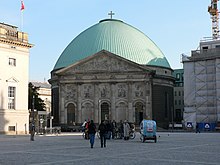St. Hedwig's Cathedral
| St. Hedwig's Cathedral | |
|---|---|

St. Hedwig's at the Bebelplatz
|
|
| Basic information | |
| Location | Friedrichstadt, a historical neighbourhood of Berlin-Mitte |
| Affiliation | Roman Catholic |
| District | 1st deanery Berlin-Mitte |
| Province | Archdiocese of Berlin |
| Year consecrated | 1773 |
| Website | www.hedwigs-kathedrale.de |
| Architectural description | |
| Architect(s) | Georg Wenzeslaus von Knobelsdorff, Jan Bouman the Elder (1747-1773), Max Hasak (1886-1887), Clemens Holzmeister (1930-1932), Hans Schwippert (reconstruction 1952-1963) |
| Architectural style | Neoclassical |
| Completed | 1773, 1887 (dome), 1932 (interior), 1963 (reconstruction) |
| Direction of façade | north-west |
St. Hedwig's Cathedral (German: Sankt-Hedwigs-Kathedrale) is a Roman Catholic cathedral on the Bebelplatz in Berlin, Germany. It is the seat of the archbishop of Berlin.
St. Hedwig's Church was built in the 18th century following a request from local parishioners to King Frederick II. He donated the land on which the church was built. The church was dedicated to the patron of Silesia and Brandenburg, Saint Hedwig of Andechs. It was the first Catholic church built in Prussia after the Protestant Reformation. The building was designed by Georg Wenzeslaus von Knobelsdorff and modeled after the Pantheon in Rome. Construction started in 1747, interrupted and delayed several times by economic problems. It was not opened until November 1, 1773, when the king's friend, Ignacy Krasicki, the Bishop of Warmia (later Archbishop of Gniezno), officiated at the cathedral's consecration.
After the Kristallnacht pogroms that took place over the night of 9–10 November 1938, Bernhard Lichtenberg, a canon of the cathedral chapter of St Hedwig since 1931, prayed publicly for Jews in the evening prayer following. Lichtenberg was later jailed by the Nazis and died on the way to the concentration camp at Dachau. In 1965 Lichtenberg's remains were transferred to the crypt at St. Hedwig's.
...
Wikipedia
